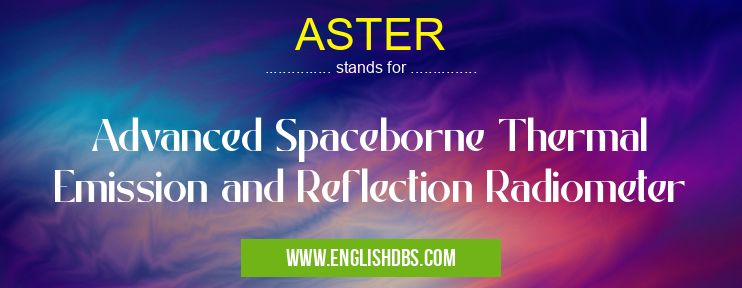What does ASTER mean in METEOROLOGY
The term ASTER stands for Advanced Spaceborne Thermal Emission and Reflection Radiometer. This is an imaging instrument, developed by Japan’s Ministry of Economy, Trade and Industry (METI) with joint collaboration between the United States National Aeronautics and Space Administration (NASA) Goddard Space Flight Center (GSFC). It was launched aboard Terra satellite in 1999 December 18 as a part of NASA Earth Observing System. ASTER is used to detect visible radiation, thermal infrared, and near-infrared radiation spectrum data of landscapes at high spatial resolution. The radiometer takes detailed measurements of land cover conditions on earth’s surface such as albedo, elevation, vegetation properties etc.

ASTER meaning in Meteorology in Academic & Science
ASTER mostly used in an acronym Meteorology in Category Academic & Science that means Advanced Spaceborne Thermal Emission and Reflection Radiometer
Shorthand: ASTER,
Full Form: Advanced Spaceborne Thermal Emission and Reflection Radiometer
For more information of "Advanced Spaceborne Thermal Emission and Reflection Radiometer", see the section below.
Essential Questions and Answers on Advanced Spaceborne Thermal Emission and Reflection Radiometer in "SCIENCE»METEOROLOGY"
What is the Advanced Spaceborne Thermal Emission and Reflection Radiometer (ASTER)?
ASTER is a space-based imaging system developed by Japan’s Ministry of Economy, Trade, and Industry. It measures visible and infrared energy reflected from Earth’s surface, providing detailed information on land cover, topography, geology, and vegetation.
How does ASTER work?
ASTER captures images using three different spectral bands in its radiometric imager: visible light (0.52 - 0.86 µm), shortwave infrared (1.6 - 2.43 µm), and thermal infrared (8 - 12 µm). Data collected from these sources can be used to identify surface features such as land cover types, terrain slope and aspect, biophysical parameters such as albedo and emissivity, surface temperature of water bodies and ice caps, etc.
What are the advantages of using ASTER?
Several advantages come with using ASTER for remote sensing research. First, it provides high spatial resolution across a wide range of wavelengths which allows users to more accurately identify physical features within an image. Additionally, because it uses both optical and infrared sensors it can distinguish between various types of surfaces such as soil moisture levels or snow cover which aids in environmental monitoring. Finally, ASTER has both day/nighttime capabilities which provide more accurate data collection no matter when researchers observe the area of interest.
What type of data can be collected from ASTER?
The data collected from ASTER covers a variety of information such as variations in elevation along with colors associated with specific areas within the scanned image area(s). Temperature measurements can also be extracted from each satellite scan allowing researchers to gain insight into ocean currents or atmospheric conditions whilealso assessing glacier activity or desertification patterns.
How often does ASTER collect its data?
The satellite collects new data an average rate of once every 16 days although it has been known to take up to 22 days in some cases depending on weather conditions at launch time. Additionally certain specific areas may be rescaned more frequently if warranted by special circumstances.
How long does it take for the data acquired by ASTER to become available for use?
Within 24 hours after an observation is recorded all results are processed through post-processing software where they are calibrated before becoming available for download by registered users via the internet. Depending on how busy the system is this process can take anywhere from one hour up to several hours.
Is access to raw images collected by ASTER open to public use?
No raw images created with using the satellite's technology is not open for public use nor should any imagery produced using analysis techniques derived from them be made available either without permission first obtained from their respective owners or copyright holders listed in the NASA Earthdata license agreement before doing so.
Can I use images taken by ASTER for free?
Images taken with Astro imagery are governed under strict copyright laws that require authorization prior to usage unless they are part of specifically designated product downloads provided by NASA through their EarthData portal which permits only limited personal or educational usage free of charge under certain provisions outlined in their licence agreement page.
Final Words:
In conclusion, ASTER stands for Advanced Spaceborne Thermal Emission and Reflection Radiometer; it is an imaging instrument launched by NASA aboard Terra satellite in 1999 December 18th for observing landscapes utilizing 15 spectral bands reflecting off visible radiation, thermal infrared,near infrared spectrum data providing environment related parameters like terrain level variations,albedo values etc., all helping us have better understanding about our planet earth thereby aiding in analyzing past trends allowing us create accurate forecasts regarding climatic changes caused due to human activities.
